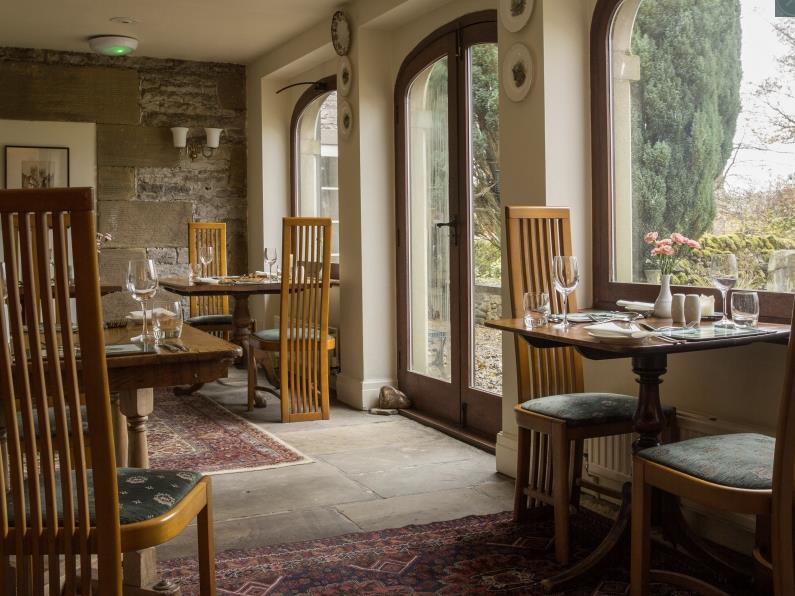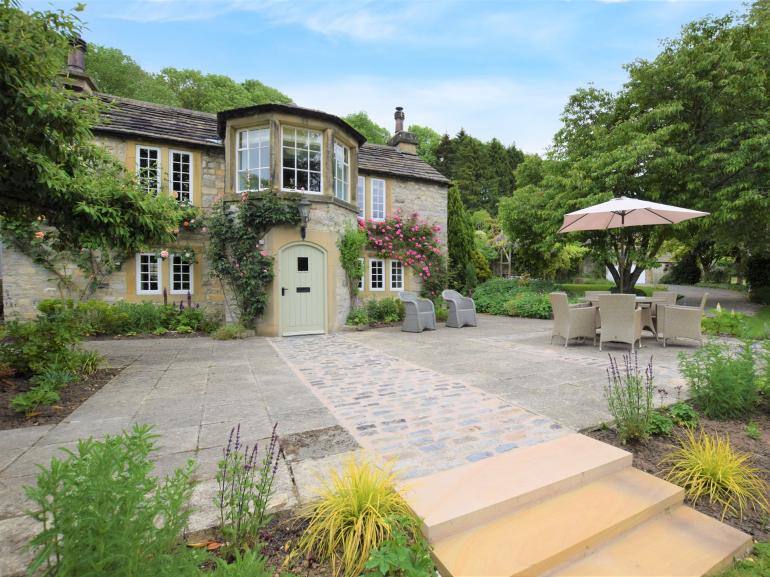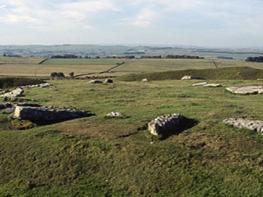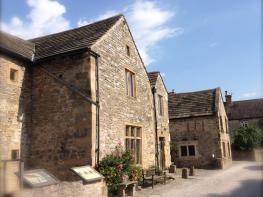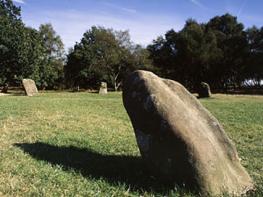Situated on a hill farm in the Peak District village of Monyash, Spingle Barn makes a perfect…
Limestone Way: Monyash to Castleton

Mostly high level across the central limestone plateau, this is a walk with ever changing views, interspersed with gentle dales and one plunging descent
13.1 miles (21.1kms)
About the walk
This northern stage of the Limestone Way leads into the heart of the Peak District National Park, beginning on the high limestone plateau south west of Bakewell, where a seemingly endless patchwork of fields is separated by miles and miles of drystone walls. There’s a long descent into Miller’s Dale and the steep path back out provides the only significant climb of the day, after crossing the River Wye beneath the huge former railway viaducts. The smaller Peter Dale and Hay Dale offer much easier walking, both peaceful retreats rich in wild flowers. The walk ends where the White Peak meets the Dark – the switch from limestone to gritstone – and as you drop down to the busy honeypot of Castleton the high moors to the north signal a very different Peak District landscape.
Walk directions
From Monyash the character of the walk changes as you head out across the high limestone plateau and the views gradually become more expansive. Leave the village heading north on Chapel Street, past a noticeboard by the car park that gives some interesting historical information about the village. Carry on along footpaths into the bottom of a dry valley, where the route is clearly waymarked. Following drystone walls, the route skirts Knotlow Farm and joins a tarmac track to reach a road at the hamlet of Flagg.
Flagg is a quiet, unassuming place, and from here you follow a lane past the houses heading northwest and go across the Bakewell–Chelmorton road. To the west, Chelmorton is famous for its pattern of narrow enclosure walls, a classic illustration of medieval farming practice. A green lane leads northwards, over the edge of the escarpment to give a really fine view of the Limestone Way through the valley and hills beyond. Follow the winding track down the hillside to carefully cross the A6, one of only two major roads to be encountered on the entire walk, by The Waterloo hotel, close to a blind brow.
The route now follows a quiet cart track downhill by the side of Blackwell Dale. Overgrown with wild flowers in summer, it is a reminder of the way many of our roads used to be. At the bottom, join the B6049, going downhill into Miller’s Dale, seemingly carved out of the limestone bedrock by the side of the River Wye. The road passes under the formidable viaduct, built to carry the former railway line that has now become the Monsal Trail. Miller’s Dale was famous for its lime, and the remains of 19th- and 20th-century kilns can be seen near the station.
From Miller’s Dale the route goes north, forking uphill beyond the church and then doubling back up a steep track which zigzags past Monksdale Farm. A walled track leads on across fields to a quiet lane near Monksdale House, where the route turns downhill to follow a path through the delightful nature reserve of Peter Dale.
Past Dale Head Farm, the route continues along Hay Dale before turning uphill on a walled track, passing a sheepwash on the way to the long, straight lane that crosses the track ahead. From here, it is just under a mile (1.6km) to the A623, where the route turns left for about 150yds (135m). It is best to walk on the grass verge for safety. The right turn is among trees by the side of Mount Dale Farm, on to a walled green lane.
Down in the next valley a minor road leads up to Cop Farm on the hillside ahead. Beyond here a field path continues over the hilltop and out across the high pasture towards Castleton. This area was once extensively mined for lead and the bumpy, part-wooded strip of Oxlow Rake, to the left, represents a line of former workings, ‘rake’ being the common name for a large vein of lead. This area was also quarried for limestone and Eldon Hill, over on the skyline to the left, only closed in 1999, since when there has been some re-landscaping and nature has slowly begin to take over once more.
From Old Moor the summit of Mam Tor is now glimpsed across the hillside ahead. The route now crosses a wide track, still following Limestone Way signs, for a faint path beyond the gate and stile opposite that crosses springy turf usually grazed by sheep. The route goes gradually downhill and bears right to join the path going down the side of Cave Dale, a water-cut limestone dale that was formed in the Ice Age and is now completely dry. The path is sometimes steep and rocky and care is needed if wet. Peveril Castle, in a fine position on the ledge ahead, is worth a visit once you reach Castleton. It was built by William Peveril, an illegitimate son of William the Conqueror, who was made Steward of the Royal Forest of the Peak, which was an important hunting area. With a curtain wall, Peveril was one of the earliest Norman stone-built castles to be built in England. It was mentioned in the Domesday Book and is sited in an almost impregnable position between Peak Cavern and Cave Dale.
Once past the castle, the path leads down to Castleton’s small square, and the end of the Limestone Way. There is a good selection of pubs, tearooms and cafés to choose from in this pleasant village, with its show caves and amenities, making it an excellent place to finish the walk. From Castleton, there is a magnificent ridge walk between Mam Tor and Hollins Cross, which can be approached via footpaths that pass Blue John Cavern and Treak Cliff Cavern, returning via Dunscar Farm. The entire trip is approximately 5 miles (8km).
Additional information
Field paths, lanes and green tracks
Across the high limestone plateau and through several dales
Good on walled green lanes, but also plenty of fields with livestock, so on lead or under close control
Chapel Street car park, Monyash
Monyash, Miller’s Dale station, Castleton
WALKING IN SAFETY
Read our tips to look after yourself and the environment when following this walk.
Find out more
Also in the area
About the area
Discover Derbyshire
The natural features of this central English county range from the modest heights of the Peak District National Park, where Kinder Scout stands at 2,088 ft (636 m), to the depths of its remarkable underground caverns, floodlit to reveal exquisite Blue John stone. Walkers and cyclists will enjoy the High Peak Trail which extends from the Derwent Valley to the limestone plateau near Buxton, and for many, the spectacular scenery is what draws them to the area.
The county is well endowed with stately homes – most notably Chatsworth, the palatial home of the Duke and Duchess of Devonshire, with its outstanding collections of paintings, statuary and art. Other gems include the well preserved medieval Haddon Hall, the Elizabethan Hardwick Hall, and Kedleston Hall, whose entrance front has been described as the grandest Palladian façade in Britain.
The spa town of Matlock is the county’s administrative centre and other major towns of interest include Derby and the old coal mining town of Chesterfield, with its crooked spire. Around the villages of Derbyshire, look out for the ancient tradition of well dressing, the decorating of springs and wells – the precious sources of life-sustaining water – with pictures formed from flowers.
Nearby stays
Restaurants and Pubs
Nearby experiences
Recommended things to do
Why choose Rated Trips?
Your trusted guide to rated places across the UK
The best coverage
Discover more than 15,000 professionally rated places to stay, eat and visit from across the UK and Ireland.
Quality assured
Choose a place to stay safe in the knowledge that it has been expertly assessed by trained assessors.
Plan your next trip
Search by location or the type of place you're visiting to find your next ideal holiday experience.
Travel inspiration
Read our articles, city guides and recommended things to do for inspiration. We're here to help you explore the UK.


